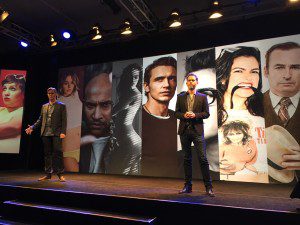 Playboy’s first NewFront is Friday and the publisher is treating the event as a “multi-platform” coming-out party.
Playboy’s first NewFront is Friday and the publisher is treating the event as a “multi-platform” coming-out party.
Following its recent rebrand as a safe-for-work men’s lifestyle media option, Playboy wants to attract more millennial males.
The publisher’s first no-nude print issue in Playboy history ran in March.
The rebrand is a key moment. Despite Playboy’s position as an iconic media brand steeped in Americana, it has struggled to improve print circulation, and the company is now seeking a buyer with a proposed $500 million price tag.
But Phillip Morelock, Playboy’s chief digital officer, claims advertiser interest has been strong since the rebrand.
“We did a deal with Dodge around our magazine relaunch, which was the first deal we’ve done with a Detroit manufacturer in 25 years, so we’re confident this is working,” he told AdExchanger. “I’ve been on 300 sales calls in the last four months, and the message is really getting out there.”
Playboy on Friday revealed a new branded content studio called Playboy Studios, staffed with about a dozen professionals it pulls from several divisions – marketing, creative, photography and video.
The company also has prepared a slate of original programming, much of which will focus on longer-form video it hopes will appeal to over-the-top audiences.
Playboy has a tvOS app for Apple TV, and is close to shipping its Roku app. This is a change from last year, when the publisher prioritized short, snackable video intended for online consumption.
“Playboy has phenomenal advantage in these crowded OTT environments where you see dozens of apps available to you and the great rebundling is happening,” Morelock said. “We feel big, strong media brands will really break through in that cluttered environment.”
Partly as a result of its new video material, the publisher expects to reach more than 150 million consumers each month. It claims to have more than 32 million users across social platforms, as well as 16 million monthly uniques on Playboy.com.
“Far less than 50%” of Playboy consumption now happens on its owned-and-operated properties, and 80% of its traffic is coming from smartphones and tablets, according to Morelock.
“I would say I aspire to grow our on-platform audience by looking at ways to drive community engagement to keep audiences on our properties, but also to entertain people wherever they are,” he said.
“The relevant question is whether you’re building a brand, an audience and a fan base that wants to engage with you. If you don’t have that, it doesn’t matter what your distribution strategy is.”
Although he didn’t name specifics, Morelock said traffic “really exploded” after Playboy removed nudity and adult content because it could take advantage of wider distribution opportunities.
Prior to that, Playboy largely got its traffic from search.
 As such, social video has become increasingly important to the publisher. Playboy monetizes video in a variety of ways, including through YouTube, direct-sold pre-roll and a partnership with TubeMogul for audience extension off-site, as well as on Instagram and Facebook, a platform which, Morelock joked, “is making us all phenomenally rich.”
As such, social video has become increasingly important to the publisher. Playboy monetizes video in a variety of ways, including through YouTube, direct-sold pre-roll and a partnership with TubeMogul for audience extension off-site, as well as on Instagram and Facebook, a platform which, Morelock joked, “is making us all phenomenally rich.”
Playboy has a “pretty robust ad stack,” and licenses most of that technology, according to Morelock. He said Playboy’s data management platform integrates with buyers’ systems to tap into its audience data set pretty consistently.
One segment Playboy promises advertisers access to are gamers who aren’t “Gamers” with a capital G, but see gaming as part of their off-hours lifestyle.
“We’ve already booked more gaming revenue [in four months] this year than all of last year,” Morelock said. “It’s going to be a phenomenal growth category for us.”












